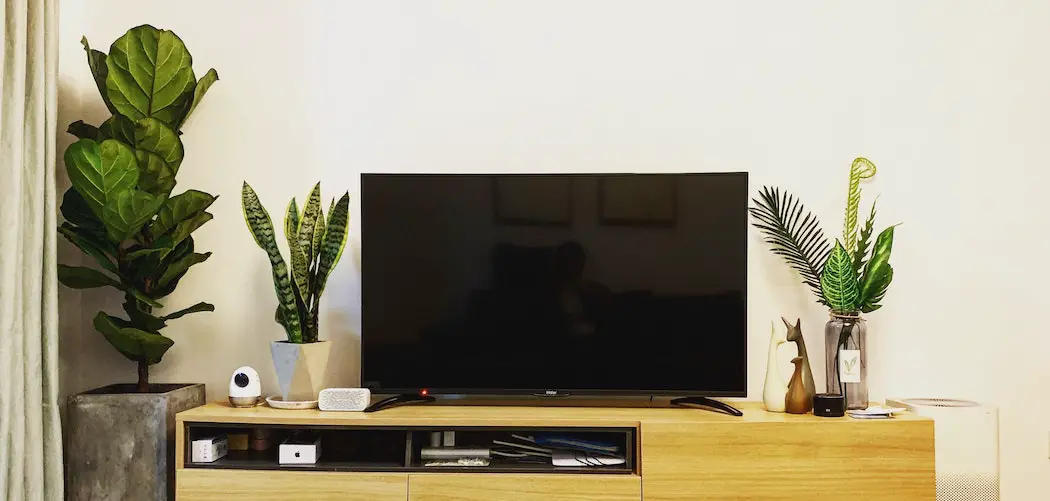If you’ve got a TV and you’re thinking about the first steps in plant care, you’re probably wondering what things you should keep away from your plants to ensure that they are as healthy as they can be.
You might be looking at your television set and wondering whether it could possibly do harm to your plant, and how far from it your plant needs to stand?
It’s unlikely that your TV will do any direct harm to a plant. You shouldn’t worry about your plant being close to a television as long as your TV isn’t getting too hot, and is still getting plenty of light. If your TV is in a dark corner or near a radiator, your plant may suffer – but otherwise, it should be fine!
Can A TV Harm Or Kill Plants?
No, a TV shouldn’t do any harm to a plant. TVs don’t – as far as we are currently aware – output anything that would do damage to a plant, stunt its growth, or prevent its seeds from germinating.
TVs are generally considered safe to be near any living beings, and that includes plants.
I’ve often put plants on or near my TV, and I’ve never noticed any problems with them. They grow perfectly happily as long as I meet their other needs.
A dead plant on a TV unit might cause you some concern, especially if it happens more than once.
However, if something is killing your plants around the TV, you should look for other culprits than your television set. It isn’t directly causing any problems for the plant, but certain other things might be.
Take a look at the setup around your TV and see if the conditions are right for the plants you are trying to grow.
Remember that different plants need different light levels, so if your television is in a dark corner or deliberately shaded to keep light off the screen, you may need to re-think where you’re putting your plants.
Try reading up on the plants that you have and see what their requirements are.
The most likely explanation for dead plants near a TV is lack of light, so this is the first thing to check and correct.
Can You Put Plants Near The TV?
Yes you can put plants near the TV, provided the other conditions are right.
Indoor plants need a certain amount of light and some plants also require humidity – these ones should probably not be grown near a television, as the humidity could damage the television, and being dry will upset the plant.
Light levels are the most important thing to take into account.
Research the plant that you want to grow to see how much direct light it needs. Direct light means light coming in through a window and hitting the plant on its leaves, so many plants that require direct light will need to be close to or on a windowsill.
If you choose a plant that will more readily tolerate shade, you should be able to put it closer to the television.
However, if you notice it craning toward the light, you may have to relocate it to keep it happy, or you’ll get a leggy, unbalanced plant that is not growing well. If conditions are too poor, the plant may die.
You should also check how hot the room gets around your TV when it’s on.
If it’s late in the summer, you might find that the room is getting too hot for the plant, and the TV will not be helping with that problem because it outputs heat.
Depending on the type of television you have, it might output a surprising amount of heat.
Check how hot the area is getting if you notice one of your plants looking a little droopy, especially if you also use a gaming console – these can get very hot indeed.
I wouldn’t stand plants on a gaming console that is used frequently.
Otherwise, being near a television or on a television stand shouldn’t really affect your plants in any noticeable way.
They may get slightly more dusty, since televisions tend to attract dust, but that’s about it!
Can TV Light Be Used As Grow Light For Plants?
You might think that if light levels are the problem, it’s easy enough to solve by leaving the television on, but that isn’t the case, no.

For starters, it will be bad for your television; the bulb will eventually burn out, as they aren’t designed to be on full time.
That is a pretty expensive way to get a grow light!
Secondly, the television won’t really provide the light that your plant needs.
To grow, a plant needs a full spectrum bulb and the right amount of light for at least some hours each day.
Red light can help your plants grow lots of leaves, and blue light helps plants regulate their cycles and know when to flower.
Without both wavelengths of light, your plants will struggle to grow, and a television won’t provide that consistently, if at all.
Televisions also do not output much light, and your plant will do much better with a real grow bulb.
If the room is too dark to grow the plants you like, think about buying one – they are usually inexpensive and easy to set up.
If you are looking for a real growing bulb that offers a great bang per buck I recommend this one, which offers a full blue to red spectrum. You’ll get two bulbs, and you can set your plant up with all the light it needs, regardless of where it’s located in the room or how dark your space is.
If you’d like a bigger pack so you can light up more than one room, try these 4 pack of bulbs, which also offer full spectrum light for even better price. Once again, you can screw them in wherever necessary and give your plants the best possible environment for growing in.
Alternatively, if you want an all-in-one product that is lamp and bulb in one, consider this one. It’s the one that I use, it is amazing and can even be angled to ensure your plants have the best possible light at all times.
You can simply turn these off when you want to use the television, so you don’t end up with any glare on the screen.
9 Best Plants To Put Next To The TV
Plants can look great next to a TV, adding a splash of green color and nature to brighten up and soften the “tech edge” of the television. A bit of color from the flowers is also a good way to make your room beautiful.
1. Lady Palm (Rhapis excelsa)
These are the quintessential TV plants for a reason.
They look amazing, they thrive in household conditions, don’t need much to drink and tolerate shade very well.
As far as care goes, try to maintain the soil moist which isn’t too hard if you keep the plant in the shade. Feed the plant very rarely, once or twice a year only if you think it’s required, but no more than that.
Normal household temperature is perfect for it, so if your TV is near the radiator like mine is, move the plant to the other side.
Radiator heat can dry the soil and roots very quickly without you noticing and can harm the plant.
In fact, I wrote this in depth post you can check out about growing plants near radiators that will explain all you need to know.
Lady Palms don’t shed and although they can get pretty tall, they are very slow growers.
More importantly however, they look lovely by a TV.
2. Spider Plant (Chlorophytum Vittatum)
Another option that will thrive, even in low light, is the legendary spider plant.
The attractive leaves dripping down can hide television bevels or cover a shelf with pretty green and cream edges.
Caring for spider plants is very easy, they need indirect light but do well in the shade, avoid the soil getting to dry and never feed in winter.
We have lots of these plants in our homes, and they look wonderful draped around screens – though you have to make sure the leaves don’t cover what you’re watching!
3. Rubber Plant (Ficus elastica)
Rubber plants are great air purifiers, and they look wonderful beside any television.
Their huge, impressive leaves are perfect for bringing stunning, glossy color to the space.
You need to water them when the topsoil is dry, and they will tolerate indirect light provided the room is reasonably bright overall.
One trick I can tell you about is that if those big leaves start dropping while looking healthy, you need to water a bit more.
After adjusting the plant will bounce back very fast!
4. Boston Ferns (Nephrolepis exaltata)
Boston ferns have attractive leafy foliage, and don’t need direct light. They also prefer a bright room, but won’t mind if there is no direct sun.
Their bright green foliage is guaranteed to give a splash of green to even the dullest piece of furniture or keep you cozy while watching that late night horror movie.
5. Philodendrons
Philodendrons are one of the most popular plants for shady spots. You can let them spill over the edges of their pots to hide unattractive TV stand shelves, or trail them down the edges of your television.
Their green leaves are simple and pretty, adding color without making a space feel cluttered.
6. Peace Lily (Spathiphyllum)
Peace lilies are another popular plant in many households, and offer a sophisticated looking plant with unusual tubular flowers and lots of rich, green leaves.
They are perfect for a modern aesthetic and undoubtedly a gorgeous plant.
They should manage in mid to medium bright spaces and aren’t to fussy about feeding.
The Peace Lily is a great beginner plant because when it needs more water, the leaves start drooping, giving you clear signs.
After you water you will see the plant bounce back in minutes.
Another trick with Peace lilies is that they love misting!
7. Swiss Cheese plant (Monstera deliciosa)
Swiss cheese plants are iconic and will look great growing beside a TV. You can use their amazing green stems to add height to your decor, and bring a touch of the rainforest to your living room.
These beauties like warmth, humidity and do well in indirect sunlight, perfect for that spot where the TV sits.
8. Snake plants (Dracaena trifasciata)
Snake plants prefer bright light, but they will put up with shade. Caring for Snake plants is very easy and they will adapt to most conditions, the toughest of the tough!
The Snake plant is the plant that I keep in the corners where other plants refuse to grow.
If you want a plant that is reasonably “tidy” to grow beside your television, the Snake plant is a good way to add color and interest without lots of leaves going everywhere.
9. Silver Inch plant (Tradescantia zebrina)
If you’d like another trailing plant, silver inch plants are a good option. They will drip down across surfaces and their variegated leaves look lovely.
However, if the light levels are too low for them, you might notice a loss in the color variation, which may make them less attractive.
Final Thoughts
A TV shouldn’t have any negative effect – or indeed, any positive effect – on your plant.
It doesn’t output anything harmful, but its light is not enough for your plant to grow by.
If you want to grow light-loving plants in a dark living room, you will have to invest in a grow bulb to give your plants all they need. Doing this will allow you to grow almost anything beside your TV.


